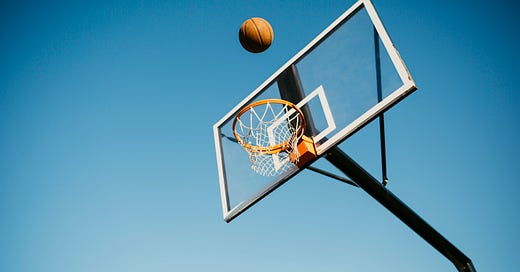Athlete or Not, Science Says to Do This if You Want to Keep Your Cool
What basketball can teach us about the game of life.
A free throw in basketball is an intensely stressful situation. All eyes are on the player. Will they or won’t they sink the shot? Merely watching is anxiety-provoking for me. It’s hard to imagine what's going through the head of the player in such a pressure-cooker moment.
In an article in Wired entitled Free Throws Should Be Easy. Why Do Basketball Players Miss? Robbie Gonzalez explores the mechanics and magic of making the shot. On paper, the free throw could not be more straightforward. It's a direct, unguarded shot at a hoop 18 inches across, 10 feet off the ground, and 15 feet away. Like a carefully controlled experiment, the conditions are exactly the same every single time.
For 20 years, Larry Silverberg, a professor at North Carolina State University, has studied the physics of the free throw using computers to simulate trajectories of millions of shots to dissect the mechanics of the perfect throw. According to his findings, a successful free throw boils down to four parameters: the speed at which you release the ball, how straight you shoot it, the angle at which it leaves your hand, and the amount of backspin that you place on it.
Of course, practice is key but not any old practice. As anyone who has ever choked on a test knows, there is often a gap between preparation and actual performance. To avoid paralysis by analysis in a free throw situation, practicing under conditions that simulate high pressure scenarios can help. Cranking up the music, using an audio of a crowd booing, having the rest of the team run around the court 10 times if the free thrower misses, and competing against the clock can help build mental stamina.
Technique and practice are important. So are your teammates. A brand new study published in Psychology of Sport and Exercise suggests a less obvious tactic to improve the performance of a free thrower: a friendly tap on the back. Before you raise an eyebrow, plenty of research shows that non-verbal gestures of support are powerful stress-reducers so it makes sense that a small gesture conveying to the free thrower that “you got this” can boost confidence. Researchers from the University of Landau and Purdue University analyzed videos of basketball games and found that the chances of scoring rose when teammates showed their support through touch, such as a hand on the shoulder. Put simply, in one of the most stressful athletics tasks imaginable, physical touch enhanced performance.
There is a lesson here for those of us who don’t often find ourselves in the middle of a heated basketball game. Gestures of support matter in everyday life and they need not always be spoken. Showing that you care does not always require an in depth discussion. A pat on the back, a warm hug, and holding hands are powerful communicators of affection. People who experience higher “felt love” – brief experiences of love and connection in everyday life – also have significantly higher levels of psychological well-being, which includes feelings of purpose and optimism compared to those who had lower felt love scores.





Wow, Doc...what a compelling analysis. You opened my eyes to the world around me, seeing things in a different light. GREAT JOB